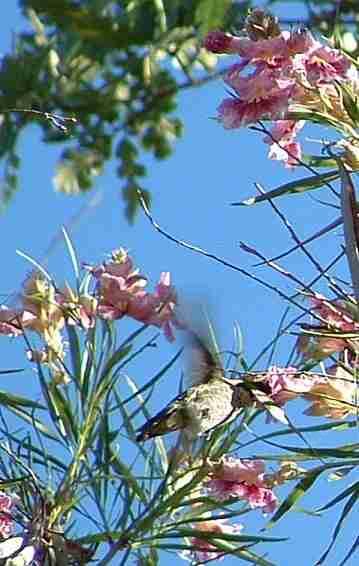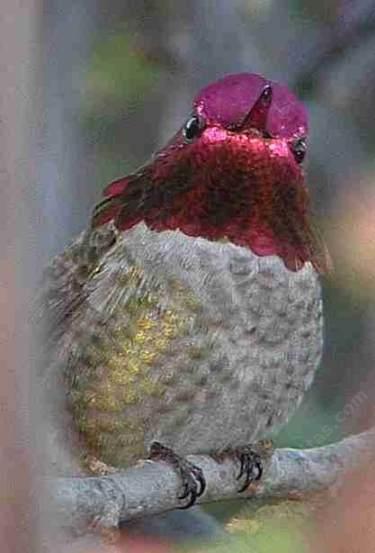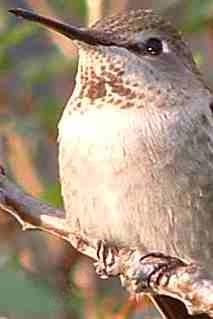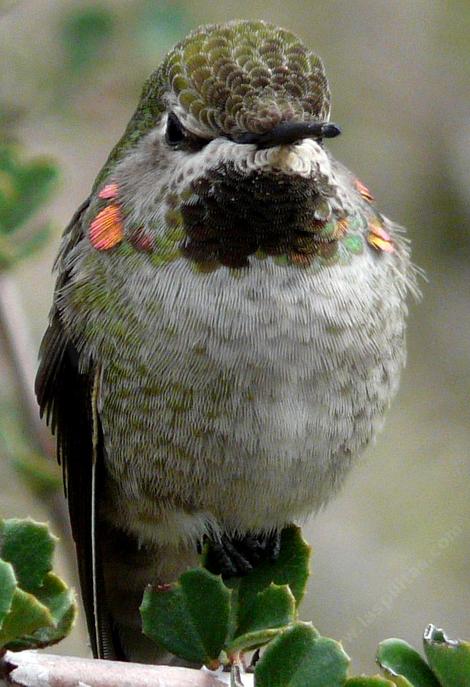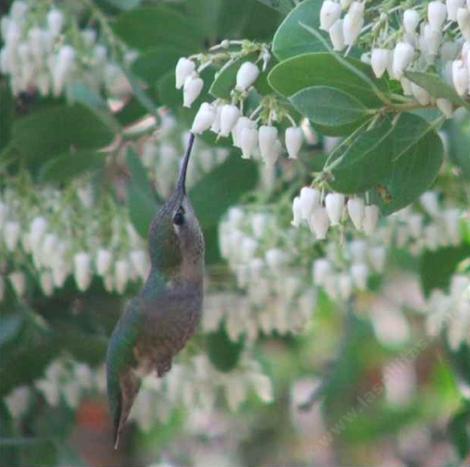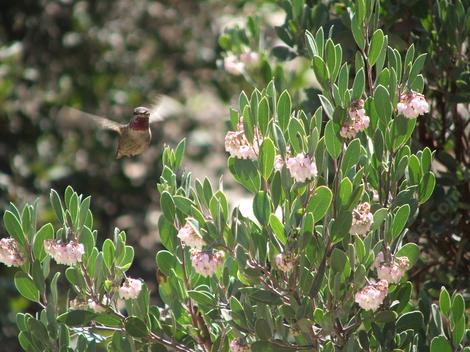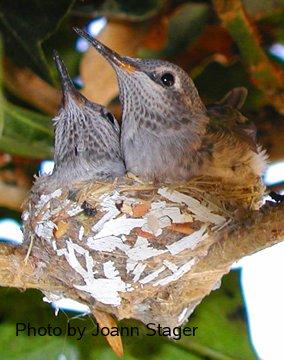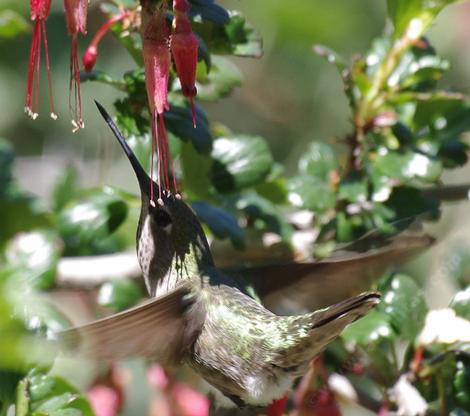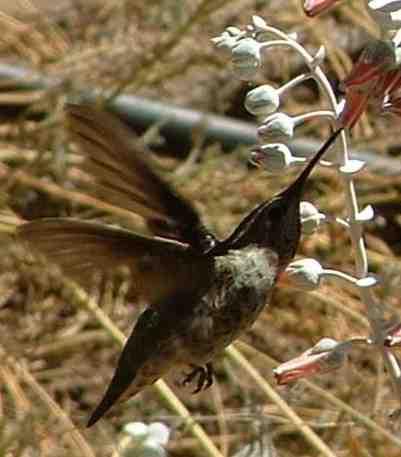Anna's Hummingbirds, Calypte anna
Diet of the Anna's Hummingbird
The Anna's Hummingbird feeds on a large variety of flowers as well as insects and spiders. The Anna's Hummingbird eats more arthropods than most hummingbirds. It is not a myth that hummingbirds favor red flowers; however, sugar content takes preference over color.
Behavior of the Anna's Hummingbird
Anna's Hummingbirds, like all hummingbirds, are incredible fliers. They can hover as well as fly backwards.
The male Anna's Hummingbird defends the food territory and the female defends the nesting territory.They are finicky eaters, as they need high energy food to maintain their incredible metabolisms. According to Welty and Baptista, the humming bird probably has the highest metabolic rate of any vertebrate.
They also have the highest heart rate of any bird. The Blue-throated hummingbird was recorded to have a heart rate of 1260 beats per minute (Lasiewski and Lasiewski, 1967). Smaller hummingbirds will have an even faster heart rate. So in order to get the most energy from their nectar collection they test each flower and upon determining the one with the highest sugar content will return to it preferentially. Areas containing flowers with high energy nectar are sought after and fought aggressively for.
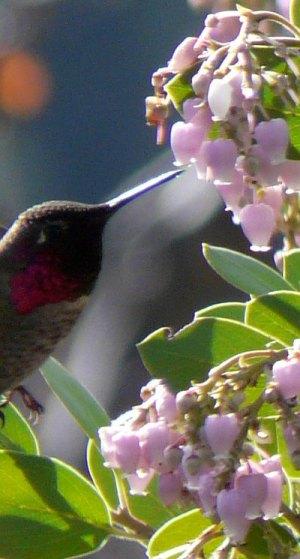
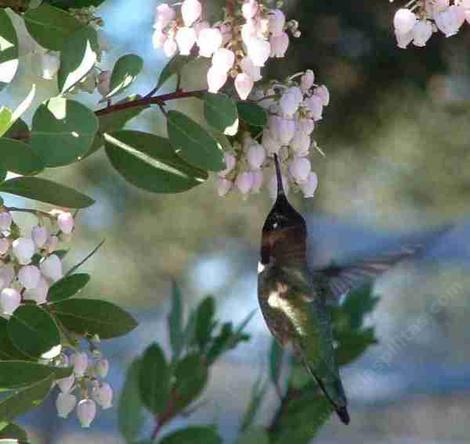
The Anna's Hummingbird also likes native Salvia species, Sags, . One of their favorites is the Hummingbird sage, Salvia spathacea. This plant forms an aggregate ground cover with large green leaves and even larger magenta flower stalks. It likes to be under Oak trees and Manzanitas and needs no water after it is established.
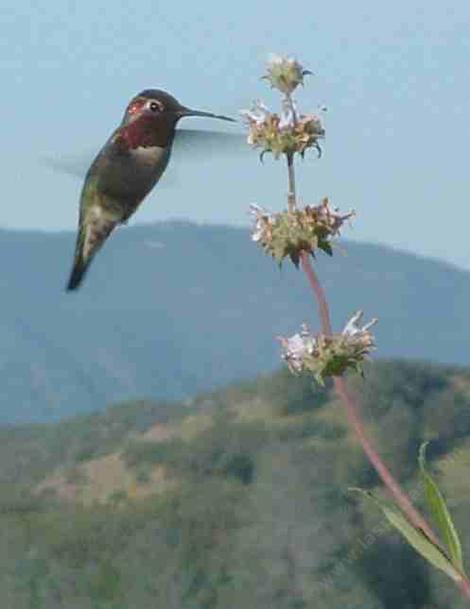
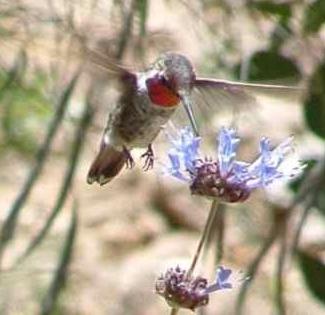
Reproduction in the Anna's Hummingbird
The male Anna's hummingbird tries to impress the female by dive bombing her. He flies very high up in the air then dives strait down toward the female when he reaches the base of the dive he makes a loud cheep sound and pulls up right in front of her flashing his brilliant red neck. He positions himself so the sun is behind the female giving her the best show of color.
Anna's Hummingbird nests are small deep cups of soft fibers lined with hair and feathers.
The female Anna's Hummingbird usually lays two eggs.
The Anna's Hummingbird likes to use the bird bath.
The Anna's hummingbird likes to get a drink on hot days. They especially like bird baths that drip as they can hover and sip water as it runs over the edge. They will also perch on the edge and drink as other birds do but they only sit still for a minute. To learn how to build a bird bath see our bird bath page. The Anna's Hummingbird is larger than other hummingbirds in California. Of course this is not saying much as it is only four inches tall. The Anna's Hummingbird is known for its magnificent red head. These feathers are only visible at a certain angle. This allows the male Anna's Hummingbird to hide when he needs to and show of when it suits him. The female only has a little red on her throat. It is common in most bird species for the female to be drab. This is so she can be less conspicuous while incubating her eggs.
One of the Anna's Hummingbirds favorite plants to feed on is Ribes specieosum.
They like all Ribes species but this is their favorite as it has the highest sugar content. This is an attractive shrub with long red fuchsia flowers and shiny dark green leaves. It is also called Fuchsia Flowered Goose Berry.
Anna's hummingbird and Dudleya
Another rock wall plant that is enjoyed by the hummingbirds is Dudleya sp, live-forever. This is a small succulent with large flower spikes. Below is a chalk Dudleya. These plants can tolerate very dry conditions and the heat of being in a rock wall.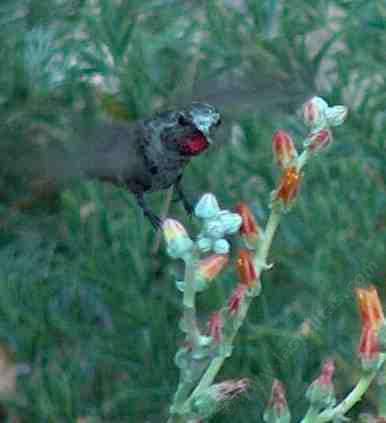
The Anna's Hummingbird and California Fuchsia
The Anna's Hummingbird also likes California fuchsia, Zauschneria californica. This is a small herbaceous perennial with red flowers. It can tolerate garden water or very dry conditions. It looks very attractive in rock walls. Placing it in a rock wall also makes it more accessible to the hummingbirds.The Anna's Hummingbird and Desert Willow
The Anna's Hummingbird also likes Desert willow, Chilopsis linearis. This is an elegant, wispy, small tree with large pink flowers. It has a nice fragrance in the evenings. It tolerates desert conditions and soils with poor nutrition.
The Anna's hummingbird also likes the Western Red Bud. This is a very attractive small tree. It is covered in magenta flowers in early spring thin in heart shaped leaves.
The Anna's Hummingbird and Manzanitas
They also like Manzanita, Arctostaphylos sp. Manzanitas are excellent for any dry garden. They can't take garden water or fertility. They like things o-natural. They are known for their attractive bark as well as their flowers and evergreen foliage. There are many kinds of manzanita. They will grow in practically in any soil in California from sand to clay. There are also all different sizes from the few inch tall “Carmel Sur” manzanita to the twenty foot tall “big berry” manzanita. Flowers are from pink to white. The Bark varies form red to black.
